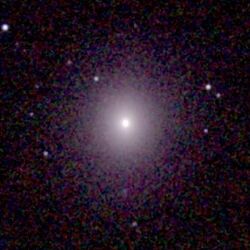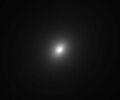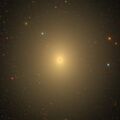Astronomy:NGC 4494
| NGC 4494 | |
|---|---|
 NGC 4494 by 2MASS | |
| Observation data (J2000 epoch) | |
| Constellation | Coma Berenices |
| Right ascension | 12h 31m 24.1s[1] |
| Declination | +25° 46′ 31″[1] |
| Redshift | 1342 ± 5 km/s[1] |
| Distance | 45 ± 10 Mly (13.7 ± 3.2 Mpc)[1] |
| Apparent magnitude (V) | 9.7[2] |
| Characteristics | |
| Type | E1-2 [1] |
| Apparent size (V) | 4.8′ × 3.5′[1] |
| Other designations | |
| UGC 7662, MCG +04-30-002, PGC 41441[1] | |
NGC 4494 is an elliptical galaxy located in the constellation Coma Berenices. It is located at a distance of circa 45 million light years from Earth, which, given its apparent dimensions, means that NGC 4494 is about 60,000 light years across. It was discovered by William Herschel in 1785.
Characteristics
The galaxy hosts a supermassive black hole with estimated mass 26.9 ± 20.4 millions M⊙, based on velocity dispersion.[3] A nuclear dust ring has been detected in NGC 4494, based on observations by the Hubble Space Telescope. It has semimajor axis 0.6 arcseconds, which corresponds to 60 parsec at the distance of NGC 4494.[4] Its ring is symmetric, implying that the dust has settled in this galaxy,[5] after the galaxy merger with a relatively gas rich galaxy that led to its creation.[6] The core of NGC 4494 is kinematically decoupled, as with many elliptical galaxies, probably a result of a galaxy merger.[7]
Dark matter
In observations by XMM-Newton observatory, the galaxy was quite faint in X-rays, nearly two orders of magnitude fainter than galaxies with similar optical luminosities. This fact has been attributed to lack of dark matter and hot gas of the galaxy.[8]
The amount of dark matter existing in the halo of NGC 4494 has been debated.[9] The galaxy is characterised as "naked" by Romanowsky et al.,[10] Napolitano et al. found that the dark matter halo has unexpectedly low central density[11] and the analysis by Deason et al. revealed an unusually low dark matter fraction, 0.32 ± 0.12 at 5Re.[12] Rodionov and Athanassoula tried to set strict constraint to the halo mass, but with only partial success.[7] On the other hand, Morganti et al. found the dark matter fraction to be about 0.6 ± 0.1 at 5Re, with particularly high dark matter fraction inside ~ 3Re.[9]
Nearby galaxies
NGC 4494 belongs to the NGC 4565 group, named after the spiral galaxy NGC 4565. Other members of the group are NGC 4525, NGC 4562, NGC 4570, NGC 4725 and NGC 4747.[13] NGC 4494 is also a member of the Coma I Group[14][15][16][17] which is part of the Virgo Supercluster.[18]
Gallery
The nucleus of NGC 4494 by Hubble Space Telescope.
SDSS image of NGC 4494
References
- ↑ 1.0 1.1 1.2 1.3 1.4 1.5 1.6 "NASA/IPAC Extragalactic Database". Results for NGC 4494. http://ned.ipac.caltech.edu/cgi-bin/nph-objsearch?objname=NGC+4494.
- ↑ "NGC 4494". SIMBAD. Centre de données astronomiques de Strasbourg. http://simbad.u-strasbg.fr/simbad/sim-basic?Ident=NGC+4494.
- ↑ Sadoun, Raphael; Colin, Jacques (11 October 2012). "-σ relation between supermassive black holes and the velocity dispersion of globular cluster systems". Monthly Notices of the Royal Astronomical Society: Letters 426 (1): L51–L55. doi:10.1111/j.1745-3933.2012.01321.x. Bibcode: 2012MNRAS.426L..51S.
- ↑ Comerón, S.; Knapen, J. H.; Beckman, J. E.; Laurikainen, E.; Salo, H.; Martínez-Valpuesta, I.; Buta, R. J. (March 2010). "AINUR: Atlas of Images of NUclear Rings". Monthly Notices of the Royal Astronomical Society 402 (4): 2462–2490. doi:10.1111/j.1365-2966.2009.16057.x. Bibcode: 2010MNRAS.402.2462C.
- ↑ Lauer, Tod R.; Faber, S. M.; Gebhardt, Karl; Richstone, Douglas; Tremaine, Scott; Ajhar, Edward A.; Aller, M. C.; Bender, Ralf et al. (May 2005). "The Centers of Early-Type Galaxies with Hubble Space Telescope. V. New WFPC2 Photometry". The Astronomical Journal 129 (5): 2138–2185. doi:10.1086/429565. Bibcode: 2005AJ....129.2138L.
- ↑ Foster, Caroline; Spitler, Lee R.; Romanowsky, Aaron J.; Forbes, Duncan A.; Pota, Vincenzo; Bekki, Kenji; Strader, Jay; Proctor, Robert N. et al. (21 August 2011). "Global properties of 'ordinary' early-type galaxies: photometry and spectroscopy of stars and globular clusters in NGC 4494". Monthly Notices of the Royal Astronomical Society 415 (4): 3393–3416. doi:10.1111/j.1365-2966.2011.18965.x. Bibcode: 2011MNRAS.415.3393F.
- ↑ 7.0 7.1 Rodionov, S. A.; Athanassoula, E. (1 January 2011). "Dynamical models of the elliptical galaxy NGC 4494". Monthly Notices of the Royal Astronomical Society 410 (1): 111–126. doi:10.1111/j.1365-2966.2010.17429.x. Bibcode: 2011MNRAS.410..111R.
- ↑ O'Sullivan, E.; Ponman, T. J. (April 2004). "XMM-Newton and Chandra observations of three X-ray-faint early-type galaxies". Monthly Notices of the Royal Astronomical Society 349 (2): 535–546. doi:10.1111/j.1365-2966.2004.07518.x. Bibcode: 2004MNRAS.349..535O.
- ↑ 9.0 9.1 Morganti, L.; Gerhard, O.; Coccato, L.; Martinez-Valpuesta, I.; Arnaboldi, M. (11 April 2013). "Elliptical galaxies with rapidly decreasing velocity dispersion profiles: NMAGIC models and dark halo parameter estimates for NGC 4494". Monthly Notices of the Royal Astronomical Society 431 (4): 3570–3588. doi:10.1093/mnras/stt442. Bibcode: 2013MNRAS.431.3570M.
- ↑ Romanowsky, A. J. (19 September 2003). "A Dearth of Dark Matter in Ordinary Elliptical Galaxies". Science 301 (5640): 1696–1698. doi:10.1126/science.1087441. PMID 12947033. Bibcode: 2003Sci...301.1696R.
- ↑ Napolitano, N. R.; Romanowsky, A. J.; Coccato, L.; Capaccioli, M.; Douglas, N. G.; Noordermeer, E.; Gerhard, O.; Arnaboldi, M. et al. (21 February 2009). "The Planetary Nebula Spectrograph elliptical galaxy survey: the dark matter in NGC 4494". Monthly Notices of the Royal Astronomical Society 393 (2): 329–353. doi:10.1111/j.1365-2966.2008.14053.x. Bibcode: 2009MNRAS.393..329N. https://works.bepress.com/aaron_romanowsky/52/download/.
- ↑ Deason, A. J; Belokurov, V.; Evans, N. W.; McCarthy, I. G. (20 March 2012). "Elliptical Galaxy Masses Out to Five Effective Radii: The Realm of Dark Matter". The Astrophysical Journal 748 (1): 2. doi:10.1088/0004-637X/748/1/2. Bibcode: 2012ApJ...748....2D.
- ↑ Makarov, Dmitry; Karachentsev, Igor (21 April 2011). "Galaxy groups and clouds in the local (z~ 0.01) Universe". Monthly Notices of the Royal Astronomical Society 412 (4): 2498–2520. doi:10.1111/j.1365-2966.2010.18071.x. Bibcode: 2011MNRAS.412.2498M. http://www.sao.ru/hq/dim/groups/galaxies.dat. Retrieved 20 July 2017.
- ↑ "Nearby Groups of Galaxies". http://ned.ipac.caltech.edu/level5/Dev2/frames.html.
- ↑ R. B. Tully (1988). Nearby Galaxies Catalog. Cambridge: Cambridge University Press. ISBN 978-0-521-35299-4.
- ↑ A. Garcia (1993). "General study of group membership. II - Determination of nearby groups". Astronomy and Astrophysics Supplement 100: 47–90. Bibcode: 1993A&AS..100...47G.
- ↑ Giuricin, Giuliano; Marinoni, Christian; Ceriani, Lorenzo; Pisani, Armando (2000). "Nearby Optical Galaxies: Selection of the Sample and Identification of Groups". The Astrophysical Journal 543 (1): 178. doi:10.1086/317070. ISSN 0004-637X. Bibcode: 2000ApJ...543..178G. http://stacks.iop.org/0004-637X/543/i=1/a=178.
- ↑ Gregory, Stephen A.; Thompson, Laird A. (April 1977). "The Coma i Galaxy Cloud". The Astrophysical Journal 213: 345–350. doi:10.1086/155160. ISSN 0004-637X. Bibcode: 1977ApJ...213..345G.
External links
- NGC 4494 on WikiSky: DSS2, SDSS, GALEX, IRAS, Hydrogen α, X-Ray, Astrophoto, Sky Map, Articles and images
 |



